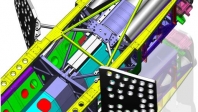
BLOODHOUND SSC has three primary braking systems: airbrakes, parachutes and wheel brakes. These will be used one-by-one to slow the car down from its top speed of over 1,000mph, taking advantage of the inherent benefits of each one:
- 1000mph: close the throttle
- 800mph: start to deploy the airbrake
- 650mph: deploy first parachute
- 400mph: deploy a second chute if required
- 200mph: apply the wheel brakes.
Airbrakes
The airbrakes are fitted at the rear of the car, one on either side in front of the rear wheels. As they fold out they will produce an extra 6 tonnes of drag (roughly equivalent to a big elephant).
Read more about BLOODHOUND’s airbrakes.
Parachutes
The parachutes are stored at the back of the car and are the same as those used in world record breaking Thrust SSC. They will be on the end of a 20 metre line to avoid the turbulence immediately behind the car. These provide around 9 tonnes of drag when deployed (that’s more than a double-decker bus).
Find out more about how the parachutes slow down BLOODHOUND.
Wheel brakes
When BLOODHOUND is tested at the Aerohub, Newquay it will be fitted with carbon wheel brakes front and rear, which are the same as those used on aircraft and high performance race cars. However, these simply won’t work at the extremes required by the desert runs in South Africa – we know, because we tested one and it exploded. Instead the desert wheel brake disks will be made from steel and fitted to the front wheels only.
Read more about BLOODHOUND’s wheel brakes.
Further information
Find out about the challenges of getting the braking systems right in this article by driver Andy Green.


